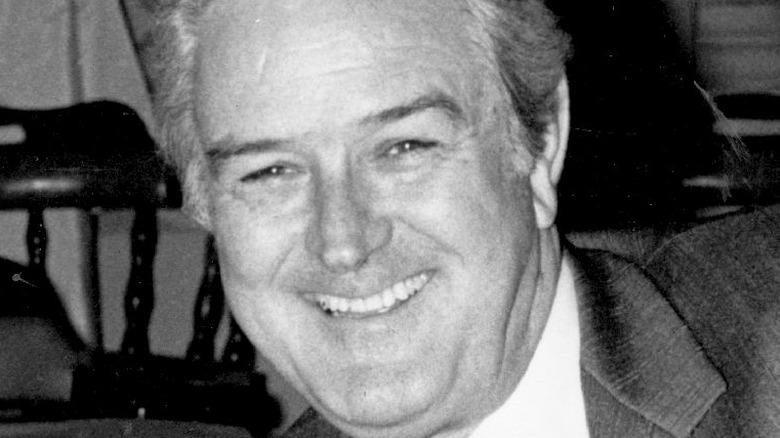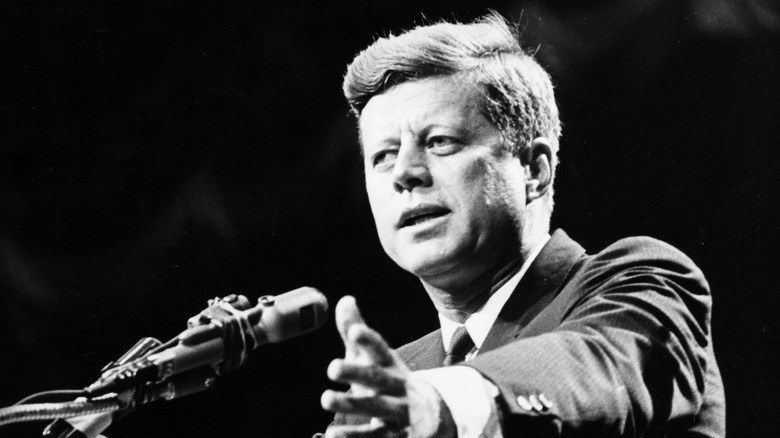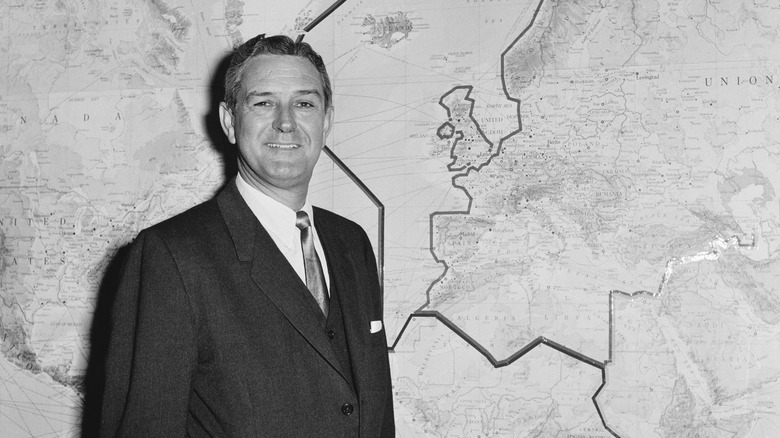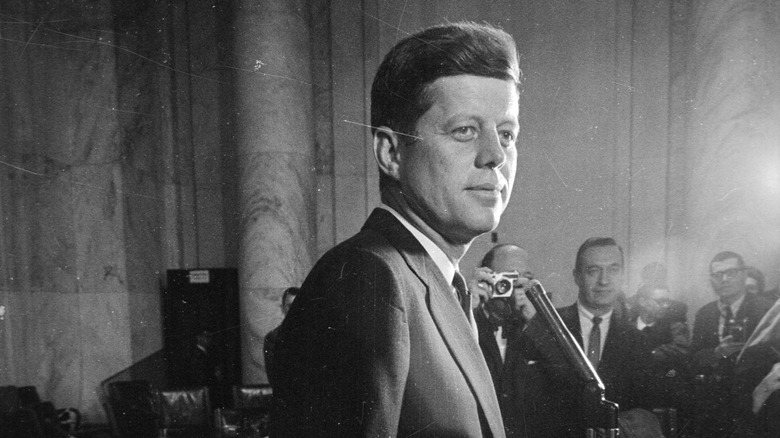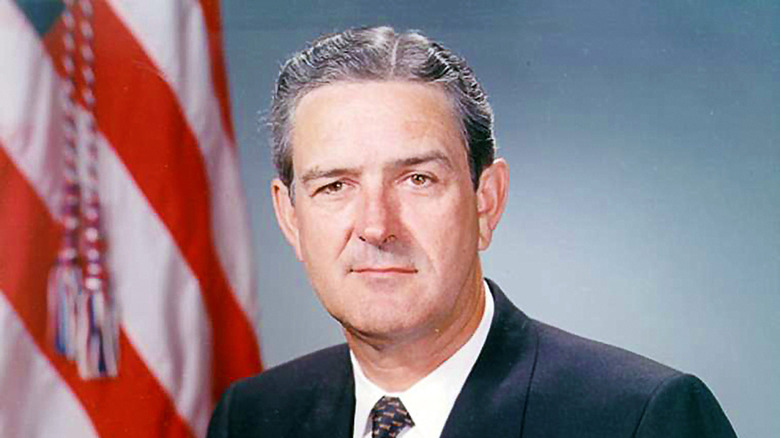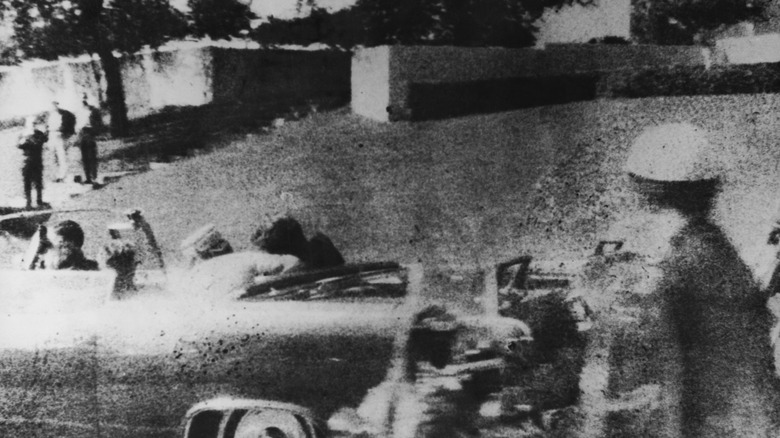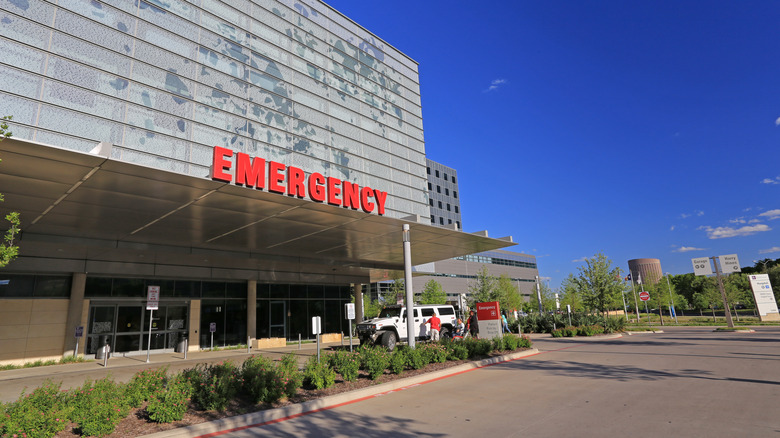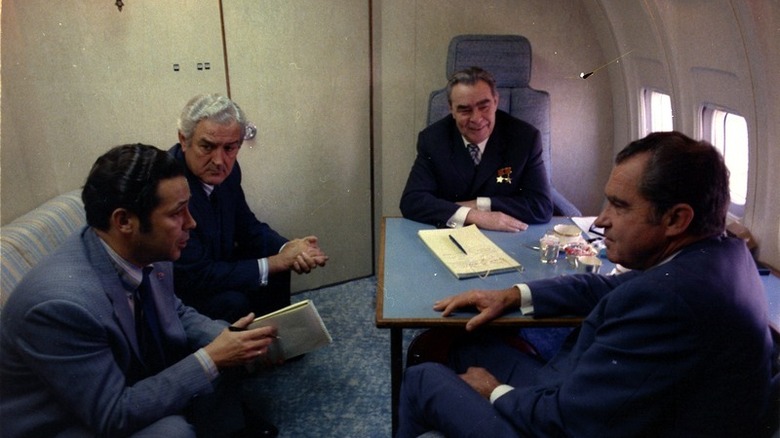How Former Texas Governor John Connally Survived JFK's Assassination
On November 22, 1963, the names John F. Kennedy and John Connally became inextricably linked. That day, Kennedy, the 35th President of the United States, and Connally, who was then the Governor of Texas, were riding in a 1961 Lincoln Continental convertible with the top down along with their wives. Several gunshots rang out in Dallas' Dealey Plaza from a sixth-floor window at the nearby Texas School Book Depository building. The shots left Kennedy dead, and one of them passed through the president and hit Connally, who survived but sustained some serious injuries.
The two politicians were only a few months apart as far as age is concerned, and they had shared a complicated history that predated that fateful moment in Dallas, which only cemented their connection to one another. In the years leading up to 1963, Connally and Kennedy were political rivals who had their differences (via The Dallas Morning News).
Kennedy's life and career
John Fitzgerald Kennedy was born in Brookline, Massachusetts, on May 29, 1917. Kennedy was born into an Irish Catholic family and was one of nine kids (via JFK Library). His father, Joseph Kennedy Sr., served as the United States ambassador to England starting in 1937, and he moved the whole family with him except for John — who the family called Jack — and his brother Joe, as the two of them were attending Harvard University.
Kennedy graduated from Harvard in 1940, and in 1941, he entered the United States Navy and wound up in the Pacific Theater of World War II. After the war, he followed after his father and jumped into politics, first becoming a congressman representing part of the Boston area before being elected to the Senate in 1953. Since he was considered to be the Democratic Party's rising star at the time, Kennedy launched a campaign to seek the Democratic nomination for the 1960 presidential election. During the primaries, he had his first run-in with John Connally (via The Dallas Morning News).
Connally's life and career
According to The Texas Politics Project, John Bowden Connally, Jr. was born on a farm near Floresville, Texas, on February 27, 1917. Connally graduated from high school and went on to study at the University of Texas beginning in 1933. There, Connally showed glimpses of his future political aspirations when he was elected president of the school's Student Association.
After graduating from the University of Texas, Connally went straight into politics. In 1939, became a secretary — or legislative assistant — to future president Lyndon B. Johnson, who at the time was serving as a congressman. Johnson became a mentor to Connally, and the two had a long history together. However, Connally had to take a sabbatical from his political career to join the U.S. Nacy reserves in 1941. Like Kennedy, he found action in the Pacific Theater during World War II and was involved in nine major air-and-sea battles, including one while aboard the USS Essex that lasted for over two days.
Connally divulges one of Kennedy's biggest secrets
According to The Dallas Morning News, John Connally had spent the better part of the 1950s working as an attorney for Sid Richardson, an obscenely wealthy Texas oil baron. Richardson died in 1959, which was the same time that his political mentor Lyndon B. Johnson was gearing up for a presidential run (via The Texas Politics Project). Connally had a reputation as a brilliant political strategist and had already managed several successful campaigns for Johnson, so it made sense that he'd recruit him again.
Of course, the big obstacle standing between Johnson and a bout with an almost-certain Republican nominee, Vice President Richard Nixon, was a young, hot-shot senator named John F. Kennedy. Johnson tried to attack Kennedy's youth — he was only 43 in 1960 — but it wasn't working. However, Nixon's campaign knew one of Kennedy's biggest secrets — that he suffered from Addison's disease, which is where the adrenal glands produce don't produce enough hormones. Kennedy had a near-fatal stay in the hospital because of the disease in 1954 after undergoing back surgery, and it was Connally who decided that divulging this information was their shot at a Hail Mary that could clinch the nomination for Johnson.
Connally announced the president's condition alongside India Edwards, who was co-chair of the Citizens for Johnson committee. JFK's press secretary Pierre Salinger later said (via The Dallas Morning News), "The India Edwards-John Connally press conference [was] about as low a blow as you will ever want to find in American politics."
Connally becomes the Governor of Texas
It doesn't take a history buff to know how the rest of the 1960 presidential election panned out. John F. Kennedy claimed the Democratic nomination and surprised everyone by selecting Lyndon B. Johnson — the man whose campaign told the world one of his most closely kept secrets — as his running mate. Then, together, they beat Richard Nixon handily, and Kennedy became the United State's youngest president in history.
But perhaps even more surprising is that John Connally wound up in Kennedy's cabinet as the Secretary of the Navy, even if it was almost entirely thanks to having his old political mentor in the White House, and because Kennedy allowed Secretary of Defense Robert McNamara to handle the hiring. McNamara later admitted that he hadn't realized there was quite a bit of bad blood between Connally and the president, though Connally was fully capable of doing the job (via The Dallas Morning News).
Still, Connally didn't last long in the White House, and within a year, he left and returned to Texas, where he had been elected governor.
Connally was wounded in Dallas
The Kennedys were in Texas for a quick tour through some of the state's biggest cities: San Antonio, Houston, Fort Worth, and Dallas. John F. Kennedy suggested the tour consist of a series of fundraisers, but John Connally said a non-partisan tour through the state was the way to go, though one fundraiser was tacked on in Austin (via The Dallas Morning News).
Of course, the tour ended prematurely in Dallas when President Kennedy was assassinated and Connally was seriously wounded. While everything surrounding the Kennedy assassination is linked to numerous conspiracy theories and alternative explanations, the Warren Commission report alleges that Governor Connally's wounds were the product of a single bullet, something he attested to.
"I ... wound up the next day realizing I was hit in three places, and I was not conscious of having been hit but by one bullet, so I tried to reconstruct how I could have been hit in three places by the same bullet, and I merely, I know it penetrated from the back through the chest first," he is quoted as saying in the report. "I assumed that I had turned as I described a moment ago, placing my right hand on my left leg, that it hit my wrist, went out the center of the wrist, the underside, and then into my leg, but it might not have happened that way at all."
How Connally survived
It's believed that the governor's position in the car — he was in the jump seat — allowed a single bullet to cause his wounds, which included severe blood loss, damage to his hand and thigh, and a collapsed lung (per MedPage Today). John Connally was in danger of dying if it weren't for the work done by the medical team at Dallas's Parkland Hospital. "The Parkland staff performed at a very high level and had great results with Connally," said Theodore Pappas, professor of surgery at Duke University.
However, that was only once they realized he was in the hospital. The moments after the shots were fired were chaotic, and most of the attention was on the president. "Connally was unattended for several minutes, gasping for breath with a collapsed lung until a resident inadvertently walked into the room and saw what was going on," medical doctor Norman Borge wrote (via MedPage Today) in his 2013 book "We Were There," which compiled stories from those involved in treating Kennedy and Connally, as well as the man who pulled the trigger, Lee Harvey Oswald.
Years after the JFK Assassination
Having survived his close call in Dallas, John Connally continued as the Governor of Texas, while his mentor Lyndon B. Johnson was sworn in as the 36th President of the United States. Connally was reelected in both 1964 and 1966, but his time as governor came to an in 1969, and he started working at a law firm (via The Texas Politics Project).
Surprisingly, Connally returned to the White House when he was selected to sit on President Richard Nixon's foreign intelligence advisory board. He became close with one of John F. Kennedy's greatest political adversaries in Nixon, though with Connally's tumultuous history with the late president himself, perhaps it was a "the enemy of my enemy is my friend" situation. Connally moved through the Nixon administration, eventually becoming secretary of the treasury before finally leaving the Democrats behind for good and joining the Republican Party. He made this switch just three months after Lyndon B. Johnson's death.
Connally died in 1993, and according to The Orlando Sentinel, he was buried with bullet fragments still in his body. The FBI requested that they be removed before his burial, but the Connally family declined.
